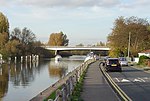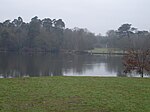Chertsey Lock

Chertsey Lock is a lock on the River Thames in England, against the left bank, an area of Green Belt including Laleham Park, the largest public park in Spelthorne. It faces the town of Chertsey and is the fifth-lowest of the forty-four locks along the non-tidal course of the river. Owing to a course alteration both banks at the site of the lock have been since medieval times in Surrey. Stone-built Chertsey Bridge built in 1785 is 210 m south (downstream) of the lock. The lock was built by the City of London Corporation in 1813, lengthened in 1893 and again in 1913. The lock adjoins a small thin island created in its building accessible by boat that connects Chertsey Weir.
Excerpt from the Wikipedia article Chertsey Lock (License: CC BY-SA 3.0, Authors, Images).Chertsey Lock
Thames Side, Borough of Spelthorne
Geographical coordinates (GPS) Address Nearby Places Show on map
Geographical coordinates (GPS)
| Latitude | Longitude |
|---|---|
| N 51.390833333333 ° | E -0.48611111111111 ° |
Address
Thames Side
Thames Side
KT16 8LD Borough of Spelthorne
England, United Kingdom
Open on Google Maps








